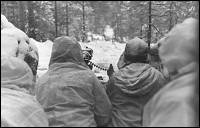1884 Se constituye el cuarto gabinete de Antonio Cánovas del Castillo desde la Restauración. Antonio Cánovas del Castillo nació el 08 febrero 1828 en Málaga. El 08 Aug 1897, cuando estaba descansando en el balneario de Santa Águeda (Guipúzcoa), fue asesinado por el joven anarquista italiano Miguel Angiolillo, que pretendía con ello vengar a las víctimas de Montjuich (Junio de 1896: Una bomba fue arrojada al paso de la procesión del Corpus, en la calle de Cambios Nuevos, en Barcelona. Hubo víctimas e inmediatamente se atribuyó el hecho a los anarquistas. Sin embargo, más tarde se ha sabido que el autor del atentado, un agente provocador al servicio de la policía, logró salir de España y fue a para a la Argentina. Pero ello sirvió para encarcelar, torturar, fusilar y deportar a los anarquistas, para poner fuera de la ley a la organización obrera por ellos orientada, la Federación de Trabajadores, y para desarticular todo cuanto, en materia de centros culturales, de escuelas laicas y de Ateneos tenían organizado los anarquistas. — les tortures i l´afusallament de cinc persones condemnades a mort per la bomba del carrer dels Canvis. La repressió que varen exercir les autoritats fou molt àmplia i dura quer va desorganitzar força el moviment anarquista. — Había Cánovas mandado reprimir con mano dura los disturbios y los atentados dinamiteros de Barcelona, por lo que fueron torturados y muertos varios anarquistas en la prisión de Montjuich [Montjuïc], sin hablar de muchos inocentes, incluyendo mujeres, encarcelados en condiciones inhumanas) — Cánovas brought about the restoration of Spain's Bourbon dynasty. He was the author of the constitution on 1876. He sent to Cuba the repressive general Valeriano Weyler y Nicolau, which, after Cánovas's death, led to war with the US and the loss of Cuba.
 2nd
German Empire proclaimed by Kaiser Wilhelm I and Bismarck. 2nd
German Empire proclaimed by Kaiser Wilhelm I and Bismarck.1871 Le 2ème Reich est proclamé A la Galerie des glaces, à Versailles, l’Allemagne réalise son unité et crée le deuxième Reich. C’est la Prusse qui a unifié le pays après les guerres contre le Danemark, l’Autriche et la France. L’unité n’a été proclamée ni à Berlin ni même sur le territoire allemand, mais dans la galerie des Glaces du château de Versailles, le 18 janvier 1871, pendant que les troupes prussiennes poursuivaient le siège de Paris, après les défaites françaises de la guerre franco-prussienne de 1870. Le peintre Anton von Werner a immortalisé la scène dans un de ses tableaux [illustration >]. On y voit le roi de Prusse Guillaume Ier, le nouvel empereur, et Otto von Bismarck qui, à sa charge de ministre-président de Prusse, va ajouter celle de chancelier de l’Empire. Ils sont entourés de princes, de militaires, de diplomates, raides, bottés et sanglés dans leur uniforme de parade ; les sabres tirés au clair soulignent le caractère martial de la scène. Pas une femme n’est présente, et le peuple est totalement absent. C’est une monarchie absolue (et peu éclairée) qui domine l’Allemagne ; c’est le militarisme autoritaire à la Prussienne qui mènera l’Allemagne aux deux prochaines guerres mondiales L'Empire allemand est proclamé le 18 janvier 1871 dans la galerie des Glaces du château de Versailles. Suite à leur victoire commune sur la France, les représentants des Etats allemands, y compris le roi Louis II de Bavière et les rois de Saxe et de Wurtemberg, font le sacrifice de leur indépendance. Sur une idée du chancelier prussien Otto von Bismarck, ils confèrent au roi de Prusse le titre d'empereur, sous le nom de Guillaume 1er. Ils choisissent avec à propos la date anniversaire du couronnement royal de son ancêtre, Frédéric 1er de Hohenzollern, le 18 janvier 1701, à Königsberg. Ce deuxième Reich (Empire en allemand) succède au Saint Empire romain germanique fondé par Otton le Grand et aboli par Napoléon 1er. Le nouvel empire est doté de deux assemblées, un Reichstag des citoyens, sans pouvoir réel, et un Bundesrat des Etats, où le royaume de Prusse prend le pas sur les autres parties de l'Allemagne. Ayant réalisé l'unité politique de l'Allemagne, Bismarck va s'atteler à son unification monétaire et économique. Nuages à venir Pendant que les Allemands triomphent à Versailles, Paris résiste au siège de leurs armées. Déclenchée par la légèreté de Napoléon III et des responsables français, la guerre franco-prussienne aura permis au chancelier Otto von Bismarck de souder les Etats allemands autour de la Prusse. L'armistice sera signée dix jours après la cérémonie de Versailles, quand les efforts de Gambetta pour poursuivre la guerre à outrance auront définitivement échoué. Les Français devront s'incliner devant la perte de l'Alsace et d'une partie de la Lorraine, le «chancelier de fer» ayant désiré que les prince allemands offrent ces terres à l'empereur en cadeau d'heureux avènement. Cette annexion va interdire l’espoir d’une réconciliation entre la France et l'Allemagne. |
1864 Skirmish at Grand Gulf, Mississippi.
1862 Confederate Territory of Arizona is formed.
 1940
Day 50 of Winter War: USSR aggression against Finland.
1940
Day 50 of Winter War: USSR aggression against Finland.  1882
Alan Alexander Milne,
English author (Winnie-the-Pooh)
1882
Alan Alexander Milne,
English author (Winnie-the-Pooh)